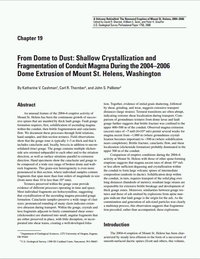An unusual feature of the 2004-6 eruptive activity of
Mount St. Helens has been the continuous growth of successive spines that are mantled by thick fault gouge. Fault gouge
formation requires, first, solidification of ascending magma
within the conduit, then brittle fragmentation and cataclastic
flow. We document these processes through field relations,
hand samples, and thin-section textures. Field observations
show that the gouge zone is typically 1-3 m thick and that it
includes cataclasite and, locally, breccia in addition to unconsolidated (true) gouge. The gouge contains multiple slickenside sets oriented subparallel to each other and to the striation
direction, as well as surface striations parallel to extrusion
direction. Hand specimens show the cataclasite and gouge to
be composed of a wide size range of broken dome and wallrock fragments. This grain-size heterogeneity is even more
pronounced in thin section, where individual samples contain
fragments that span more than four orders of magnitude in size
(from more than 10 to less than 10-3
mm).
Textures preserved within the gouge zone provide
evidence of different processes operating in time and space.
Most individual fragments are holocrystalline, suggesting
that crystallization of the ascending magma preceded gouge
formation. Cataclasite samples preserve a wide range of clast
sizes; pronounced rounding of many clasts indicates extensive abrasion during transport. Within the gouge, crystals and
lava fragments adjacent to finely comminuted shear zones
(slickensides) are shattered into small, angular fragments that
are either preserved in place, with little disruption, or incorporated into shear trains, creating a well-developed foliation. Together, evidence of initial grain shattering, followed
by shear, grinding, and wear, suggests extensive transport
distances (large strains). Textural transitions are often abrupt,
indicating extreme shear localization during transport. Comparison of groundmass textures from dome lavas and fault
gouge further suggests that brittle fracture was confined to the
upper 400-500 m of the conduit. Observed magma extrusion
(ascent) rates of ~7 m/d (8×10-5
m/s) permit several weeks for
magma ascent from ~1,000 m (where groundmass crystallization becomes important) to ~500 m (where solidification
nears completion). Brittle fracture, cataclastic flow, and shear
localization (slickenside formation) probably dominated in the
upper 500 m of the conduit.
Comparison of eruptive conditions during the 2004-6
activity at Mount St. Helens with those of other spine-forming
eruptions suggests that magma ascent rates of about 10-4
m/s
or less allow sufficient degassing and crystallization within
the conduit to form large volcanic spines of intermediate
composition (andesite to dacite). Solidification deep within
the conduit, in turn, requires transport of the solid plug over
long distances (hundreds of meters); resultant large strains are
responsible for extensive brittle breakage and development of
thick gouge zones. Moreover, similarities between gouge textures and those of ash emitted by explosions from spine margins indicate that fault gouge is the origin for the ash. As the
comminution and generation of ash-sized particles was clearly
a multistep process, this observation suggests that fragmentation preceded, rather than accompanied, these explosions.


